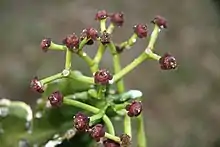| Euphorbia tanaensis | |
|---|---|
 | |
| Scientific classification | |
| Kingdom: | Plantae |
| Clade: | Tracheophytes |
| Clade: | Angiosperms |
| Clade: | Eudicots |
| Clade: | Rosids |
| Order: | Malpighiales |
| Family: | Euphorbiaceae |
| Genus: | Euphorbia |
| Species: | E. tanaensis |
| Binomial name | |
| Euphorbia tanaensis Bally | |
Euphorbia tanaensis, commonly known as the Tana River Euphorbia, is a critically endangered flowering plant from the family Euphorbiaceae, commonly known as the Spurge family. It is found in only one location on the Tana River in Kenya. Initially identified with nine trees in 1988, a subsequent survey in 2006 revealed that only four individuals remain, with no evidence of natural regeneration. Its habitat is under immediate threat from deforestation.[2]
Description
Euphorbia tanaensis is a medium-sized succulent tree of the and a member of the diverse plant genus Euphorbia. The tree stands up to 30 meters tall, and a single trunk can reaches up to approximately 50 cm in diameter. Its flowers are reduced and clustered into flowerheads called cyanthia.[3]
Distribution and habitat
Euphorbia tanaensis is only known from a singular site in Witu, Kenya. Its recorded range is limited to a range of 4 km2 (1.5 sq mi) where it grows on the periphery of wet lowland forests, particularly those dominated by Treminalia zambesiaca. This specific ecological niche contributes to the plant's distinct characteristics and vulnerability.[2]
Conservation
Euphorbia tanaensis has been listed as Critically Endangered by the International Union for Conservation of Nature. It has an estimated population of only four mature individuals and there are no known occurrences in protected areas or ex situ collections. No evidence of regeneration has been observed within the current population.[2]
As of August 2023, Kenya Forestry Research Institute (Kefri) has reportedly undertaken captive cultivation of the plant in an effort to restore their population.
Threats
The primary threats to Euphorbia tanaensis stem from human activities, notably serious logging in its habitat. Evidence of human disturbance like pole-cutting and the use of pit saws have been found in close proximity to the species, and it is suspected to be declining.[2]
References
- ↑ Beentje, H.J.; Gereau, R.E.; Hilton-Taylor, C.; Howard, G.; Kindeketa, W.; Luke, W.R.Q.; Maunder, M.; Mwachala, G.; Mwangoka, M.; Ndangalasi, H.; Njau, E.-F.; Schatz, G.E.; Siro Masinde, P.; Wilkins, V.L. (2020). "Euphorbia tanaensis". IUCN Red List of Threatened Species. 2020: e.T30898A2798380. doi:10.2305/IUCN.UK.2020-3.RLTS.T30898A2798380.en. Retrieved 16 November 2021.
- 1 2 3 4 "Euphorbia tanaensis". The IUCN Red List of Threatened Species. 2020.
- ↑ "Euphorbia tanaensis P. R. O. Bally & S. Carter articles - Encyclopedia of Life". eol.org. Retrieved 2023-12-29.
